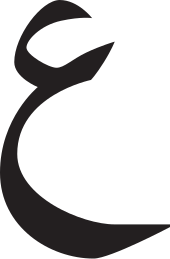ʿAin
|
|
||
|
ـع
|
ـعـ
|
عـ
|
| from the right | both sides | to the left |
ʿAin ( Arabic عين, also ʿAyn ) is the 18th letter of the Arabic alphabet . It emerged from the Phoenician Ajin ![]() and is thus related to the Latin O , the Greek omicron (Όμικρον) (Ο) and the Hebrew Ajin ע. It is assigned the numerical value 70 in Hebrew and Arabic. The 19th letter Ghain (غ) differs from ʿAin by an additional diacritical point.
and is thus related to the Latin O , the Greek omicron (Όμικρον) (Ο) and the Hebrew Ajin ע. It is assigned the numerical value 70 in Hebrew and Arabic. The 19th letter Ghain (غ) differs from ʿAin by an additional diacritical point.
Sound value and transcription
Arabic
The ʿAin has no equivalent in German. This is a voiced pharyngeal fricative ( IPA : [ ʕ ] ), in which the muscles of the throat are greatly strained and pressed together. The ʿAin is the voiced equivalent of the Ḥa and differs significantly from the Hamza vocal paragraph . In the DMG inscription, ʿAin is reproduced as a small arc (ʿ) open to the right (it should not be confused with the arc open to the left, which represents the Hamza). In non-scientific transcription, ʿAin is often given with an apostrophe or remains unmarked. In domain names , Internet forums and when using chat programs , the number “ 3 ” often represents the ʿAin.
Persian
Unlike the Arab call Ayn and Hamza in the Persian, namely the same sound voiceless glottal plosive (glottal stop) [ ʔ ] as it is spoken in English before beginning with a vowel words.
Turkish
Unlike in Arabic, the sound in Ottoman Turkish is not created by pressing the throat, but is a simple voice paragraph. The transliteration of İslâm Ansiklopedisi from 1940 is the same as the DMG transliteration from 1935 (ʿ).
Urdu
In Urdu , ʿAin is only pronounced at the beginning of the word as a vocal paragraph, and otherwise not at all. After short vowels, however, it changes these vowels into long ones , namely: a + ʿAin = long ā, i + ʿAin = long e, and u + ʿAin = long o. Eg baʿd "nach", pronounced "baad" , śiʿr “Poem”, pronounced “Scheer” , and śuʿba “department”, pronounced “schooba” .
ʿAin in Unicode
| Unicode codepoint | U + 0639 |
|---|---|
| Unicode name | ARABIC LETTER AIN |
| HTML | & # 1593; |
| ISO 8859-6 | 0xd9 |
For the transcription:
| Unicode codepoint | U + 02BF |
|---|---|
| Unicode name | MODIFIER LETTER LEFT HALF RING |
| HTML | & # 703; |
Web links
Individual evidence
- ↑ Christina Oesterheld and Amtul Manan Tahir: Urdu for beginners, Hamburg: Buske, 2016, p. 33 f.
